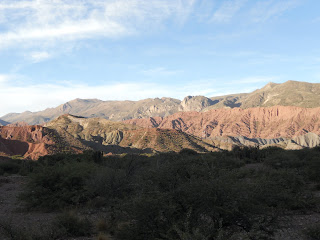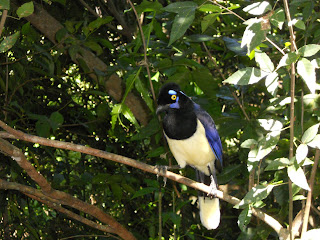Stu in the plaza:
 The view from the cable car:
The view from the cable car: Waterfalls at the top of the hill:
Waterfalls at the top of the hill: However, poor Salta will mostly stick in our memories as the place we nearly lost about 300 photos from our trip! Our biggest memory card picked up a virus from a computer (we think in Iguazu), and we couldn´t access any of the photos on it. We took the card around to various computer shops in Salta and lots of people had a go at fixing it - these episodes all started very confidently with the person in question setting to work with anti-virus software, only to end shortly after with said person turning sheepishly to us to say something along the lines of "actually, this is a really really bad virus, there´s nothing to be done". Just as we were about to write off all our photos taken from Valparaiso to Iguazu (including all our pics from living in BA and all our pics of the waterfalls), a genius guy in an internet cafe saved our photos and sent the virus packing! We were both so relieved. And this experience has eclipsed everything else about Salta.
However, poor Salta will mostly stick in our memories as the place we nearly lost about 300 photos from our trip! Our biggest memory card picked up a virus from a computer (we think in Iguazu), and we couldn´t access any of the photos on it. We took the card around to various computer shops in Salta and lots of people had a go at fixing it - these episodes all started very confidently with the person in question setting to work with anti-virus software, only to end shortly after with said person turning sheepishly to us to say something along the lines of "actually, this is a really really bad virus, there´s nothing to be done". Just as we were about to write off all our photos taken from Valparaiso to Iguazu (including all our pics from living in BA and all our pics of the waterfalls), a genius guy in an internet cafe saved our photos and sent the virus packing! We were both so relieved. And this experience has eclipsed everything else about Salta.We left Salta in the middle of the (cold) night to head to the Bolivian border. Unlike previous border crossings by bus, this border had to be crossed on foot. The Argentinian bus takes you as far as the border, then you get off and go through immigration on foot before catching another bus on the Bolivian side. The 7-hour bus from Salta was literally freezing. Having been so impressed by Argentinian buses in the past, we sat shivering on the platform in Salta consoling ourselves that we would soon be warm and cozy on the bus. Ha! The journey was so cold that the suspect water in the aisle of the bus had actually frozen by the time we arrived. The border towns are at quite a high altitude (nearly 3500m) so it stayed very cold in the early morning as we walked across a small bridge into Bolivia and queued at immigration. On the plus side, we met a nice group of backpackers on the same bus as us and we clubbed together to share a taxi to Tupiza, our first stop in Bolivia. (A two-hour shared taxi ride cost about two pounds each - Bolivia is easily the cheapest country we´ve visited in South America so far.)
As soon as we crossed the border, it was like we were in a different world. Bolivia is far less European than Argentina, and the first thing you notice is that lots of people wear traditional dress. The women in particular have amazing outfits here: skirts, brightly coloured shawls, two long blacks plaits and a bowler hat are the norm. Bolivia has the largest percentage of indigenous South American people in the whole of South America (I think), so Aymara and Quechua cultures are very present. Also - the food is much tastier and less bland than in Argentina!
Tupiza is a small, dusty town in red rock cactus country. It´s a bit lower in altitude than the border towns, but you can still notice a shortness of breath in the thin air. On one of our days there I spent a lovely afternoon out in the surrounding countryside on horseback. (As some of you already know, Stu is allergic to horses and therefore couldn´t join me. Plus I had to quarrantine everything I wore as soon as I got back!) My horse was called Pajaro (meaning 'bird'), and he was gorgeous and so well-behaved. By the end of the afternoon I was even confident enough to do a bit of galloping!
Riding through the red rocky landscape:


Tupiza was great for a couple of days relaxation, and we also arranged our trip from there through the national parks of southwest Bolivia, including the famous Salar de Uyuni (salt flats). I´ll leave it to Stu to tell you how that went...




















 Being studious types, we got some extra language practice at 'Spanglish', which was an evening event for people wanting to practice Spanish and locals wanting to practice English. It was like a language exchange crossed with speed-dating: you sit at a table with someone fluent in Spanish, and you chat for five minutes in Spanish, five minutes in English, and then move on to the next table to talk to somebody else. All this, and in a pub too! Spanglish nights had the added bonus that we made some new friends in Buenos Aires.
Being studious types, we got some extra language practice at 'Spanglish', which was an evening event for people wanting to practice Spanish and locals wanting to practice English. It was like a language exchange crossed with speed-dating: you sit at a table with someone fluent in Spanish, and you chat for five minutes in Spanish, five minutes in English, and then move on to the next table to talk to somebody else. All this, and in a pub too! Spanglish nights had the added bonus that we made some new friends in Buenos Aires.


 '
' MA-TAY', it's a kind of South American tea that's really popular here and in Uruguay) to antiques to delicious street food. The market takes over a whole cobbled street called Defensa. At one end of the road is the square, the Plaza Derrego, where on our first weekend we stood fascinated while dozens of people danced the tango with a live band at night:
MA-TAY', it's a kind of South American tea that's really popular here and in Uruguay) to antiques to delicious street food. The market takes over a whole cobbled street called Defensa. At one end of the road is the square, the Plaza Derrego, where on our first weekend we stood fascinated while dozens of people danced the tango with a live band at night:

 'Lunes a Viernes'; and we get lots of 'tareas' (homework!). Thankfully we have a big desk in our room at Susana's. It's times like this I'm glad I'm not staying in a hostel:
'Lunes a Viernes'; and we get lots of 'tareas' (homework!). Thankfully we have a big desk in our room at Susana's. It's times like this I'm glad I'm not staying in a hostel:
 's really satisfying to be able to talk to people in shops now, or ask for directions. Before we did our classes, we were completely reliant on Ania's Spanish ability, so I'm pleased to be able to contribute now, even if it's only in a small way!
's really satisfying to be able to talk to people in shops now, or ask for directions. Before we did our classes, we were completely reliant on Ania's Spanish ability, so I'm pleased to be able to contribute now, even if it's only in a small way! 't mean the fun stops there! At dusk people remain on the streets, sharing enormous, litre bottles of beer (ok, I'm dressing it up, it's called 'street drinking'!). Here's me and my friend Jonee from my Spanish class, who interestingly enough is Jonee Duggan!
't mean the fun stops there! At dusk people remain on the streets, sharing enormous, litre bottles of beer (ok, I'm dressing it up, it's called 'street drinking'!). Here's me and my friend Jonee from my Spanish class, who interestingly enough is Jonee Duggan!



 't lock me in here at night!
't lock me in here at night!
